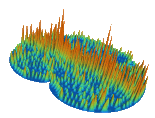Computing eigenvalues for quantum maps
This page contains additional material for the paper
A. Bäcker: Numerical aspects of eigenvalue and eigenfunction computations for chaotic quantum systems
In The Mathematical Aspects of
Quantum Maps, M. Degli Esposti and S. Graffi (Eds.),
Springer Lecture Notes in Physics 618, 91-144 (2003)
[nlin.CD/0204061]
As an example of a quantum map we use
the quantization of the perturbed cat map:
pert_cat.py
(this code is an updated version of the one
published in the paper using
numpy and now in addition
matplotlib.
Just run (for N=101 and kappa=0.3)
python pert_cat.py 101 0.3
It will compute the (complex) eigenvalues,
which all lie on the unit circle (within numerical accuracy).
After computing the eigenvalues the so-called
level spacing distribution is determined,
which is the distribution of the distances (on the unit circle) of
next-neighboured eigenvalues.
Using
matplotlib, the histogram is detetermined and plotted.
It is in resonable agreement with the exptected level spacing distribution
of the Gaussian Orthogonal Ensemble (GOE).
Increasing the size of the matrix (which corresponds
to smaller effective Planck's constant, i.e.
the semiclassical limit)
leads to better and better agreement.
Last modified: 27 March 2017, 20:11:51 ,
© Arnd Bäcker
